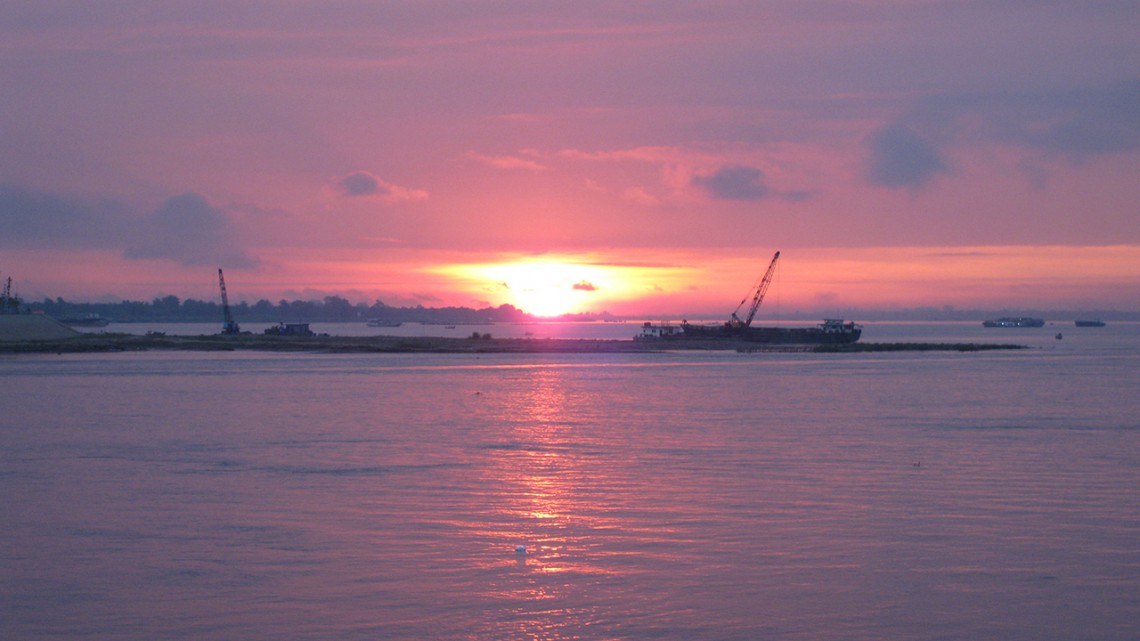
Sunrise over the Mekong River in Phnom Penh, Cambodia, downstream of the Sambor Dam site.
Researchers seek alternatives to Mekong River hydropower dam
By David Nutt
The Mekong River, flowing from the Tibetan Plateau through Myanmar, Laos, Thailand, Cambodia and Vietnam to the South China Sea, is a hotbed of ecological diversity. The roughly 60 million people who live in the region, many in poverty, depend on the river and its tributaries for food and income. But a surge in hydropower projects is threatening to plunge the Mekong River basin into catastrophic ecological collapse, hampering the flow of fish, nutrients and sediment, unless a viable alternative is found.
Enter Thomas Wild, Ph.D. ’14, who as an Atkinson Center for a Sustainable Future Postdoctoral Fellow in Sustainability teamed up with Patrick Reed, professor of civil and environmental engineering, and the nonprofit, nongovernmental Natural Heritage Institute (NHI). Together, they worked with the Cambodian government to explore alternative options for the largest, most potentially devastating dam currently planned along the Mekong, in Sambor.
“The traditional hydropower planning paradigm is for developers to look for and select dam sites that are optimized for hydropower, and then figure out how to mitigate fishery impacts later,” Wild said. “We’ve turned that on its head by focusing on ecosystem concerns from the outset, beginning with site selection.”
Wild and Reed’s resulting study, “Balancing Hydropower Development and Ecological Impacts in the Mekong: Tradeoffs for Sambor Mega Dam,” was published this month in the Journal of Water Resources Planning and Management.
The proposed Sambor dam is an 11-mile long “chunk of concrete,” in Wild’s words, that would block a major migration highway that sees up to half a million fish every hour, heading to upstream tributaries to spawn or swimming downstream to critical nursery and fishery habitats in Tonle Sap Lake and the Mekong Delta. Eventually they reach the Vietnam Delta, which is already facing ecological strain from flooding and land loss due to rising sea levels.
To show the Cambodian government better options, Wild and Reed created a modeling platform that helped the team discover an alternative dam design, called the Sambor Ecological Alternative, with design and operational features that would improve sediment and fish passage while maintaining significant hydropower production. Collaborating with a broader interdisciplinary team that included fish biologists, a dam engineer, a geomorphologist, a geographer, a lawyer and an economist, the team explored alternative siting, design and operation choices, and the specific tradeoffs in balancing energy and ecological objectives that would result.
While the Sambor Ecological Alternative would still pose a significant risk to Mekong fisheries, it demonstrated to officials in the Cambodian government, including the prime minister, that other options exist.
“What we’ve done is show decision makers that there are a range of options available to them, each with different social, ecological and economic outcomes. We helped them define metrics that characterize these outcomes and objectives, and identify alternatives that may offer more balanced outcomes than the originally proposed dam,” said Wild, a visiting assistant research engineer at the Earth System Science Interdisciplinary Center at the University of Maryland and a research scientist at the Pacific Northwest National Laboratory. “I think they’ve been more empowered to think about what their options are. ”
Since the NHI team presented their findings, the Cambodian government has been considering multiple alternatives to the original Sambor design and has expressed interest in building floating arrays of solar photovoltaic panels that would be economically viable and less disruptive to the ecosystem.
Wild and Reed hope to share their systems toolkit with other countries that have limited technical capacity but want to explore energy alternatives beyond what developers propose, allowing them to have a say in their own development.
“It’s easy to say the word alternative, but it’s not easy to generate them in a way that has sufficient salience and credibility to be relevant in a real decision-making context,” Reed said. “A lot of the complexity, nuances, uncertainty and sensitivity of these things, you have to be careful it doesn’t become an artificial mathematical exercise that is only academically interesting. It has to be integrated, interdisciplinary, and it has to have some actual relevance and legitimacy in complex real world decision contexts.”
David Nutt is managing editor of the Atkinson Center.
Media Contact
Get Cornell news delivered right to your inbox.
Subscribe
